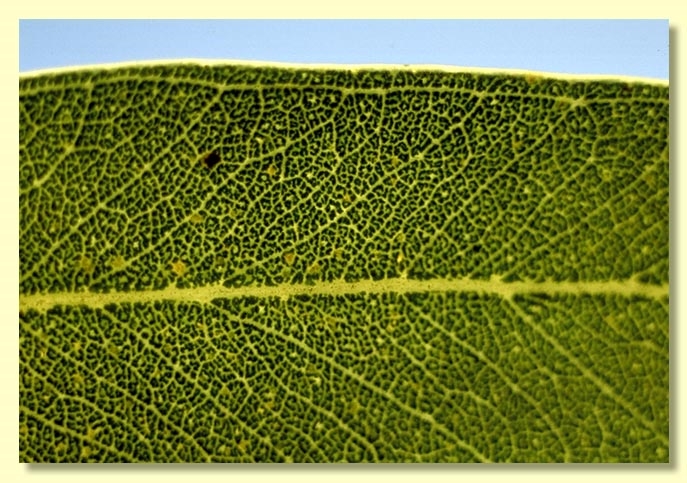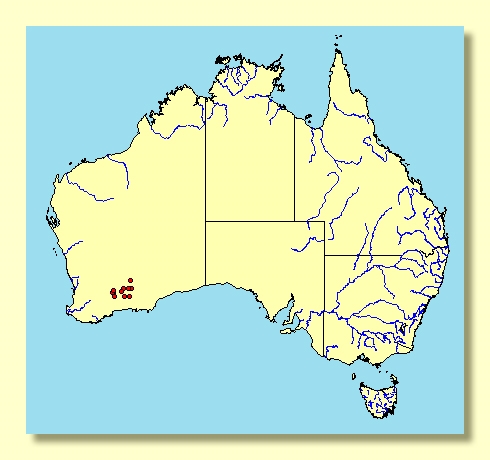Eucalyptus | Symphyomyrtus | Bisectae | Glandulosae | Levispermae | Cubiformes
Euclid - Online edition
Eucalyptus livida
Bark smooth throughout, pale grey, dark grey and orange.
Branchlets with oil glands in the pith.
Juvenile growth (coppice or field seedlings to 50 cm): not seen.
Adult leaves alternate, petioles 1–3 cm long; blade narrowly lanceolate to lanceolate, 7–11.5 cm long, (0.8)1–2.5(3.5) cm wide, base tapering to petiole, margin entire, apex pointed, concolorous, dull, grey to grey-green, side-veins greater than 45° to midrib, reticulation moderate to dense and broken, intramarginal vein remote from margin, oil glands mostly intersectional.
Inflorescence axillary unbranched, peduncles widening apically, 0.8–2.1 cm long, buds ?11 to15 per umbel, pedicellate (pedicels 0.2–0.3 cm long). Mature buds fusiform and often curved (0.9–1.5 cm long, 0.3–0.4 cm wide), scar present, operculum conical, roughly twice the length of the hypanthium and equal to it at the join, few outer stamens erect, most stamens variably deflexed, anthers cuboid, versatile, dorsifixed, dehiscing by longitudinal slits, style long and straight, stigma rounded, locules 3, the placentae each with 4 vertical rows of ovules. Flowers creamy white.
Fruit pedicellate (pedicels 0.2–0.4 cm long), usually barrel-shaped, 0.5–0.7 cm long, 0.4–0.5 cm wide, disc descending, valves 3, at rim level.
Seeds pale to mid-brown or straw coloured, 0.8–1.3 mm long, more or less spherical, surface smooth, hilum ventral/terminal.
Cultivated seedlings (measured at ca node 10): cotyledons Y-shaped (bisected); stems rounded in cross-section, scabrid; leaves always petiolate, opposite for 3–6 nodes then alternate, ovate, 4.5–7.5 cm long, 1.5–4 cm wide, dull, green, scabrid, margin irregular to undulate due to hairs. Scabridity of stems and leaves is present for at least 14 nodes. The hairs have a multicellular base surmounted by a pair of long cells that are basally appressed, and apically divergent.
Flowering time unknown.
A mallee or small tree endemic to Western Australia, found in the central and southern goldfields south to the Peak Charles area. The bark is smooth and the adult leaves dull grey to grey-green.
Eucalyptus livida belongs to Eucalyptus subgenus Symphyomyrtus section Bisectae subsection Glandulosae because the cotyledons are bisected, buds have an operculum scar and the branchlets have oil glands in the pith. Within this subsection E. livida is one of a group of 14 species that form series Levispermae subseries Cubiformes, characterised by having smooth varying from almost cuboid to more or less spherical seed (not perfectly spherical), flattened peduncles that widen apically and buds that are narrowly fusiform with some stamens erect and others variably deflexed.
E. livida, like the closely related species E. capillosa and E. nigrifunda, has strikingly scabrid seedling and juvenile growth but it differs from both of them in having non-glaucous branchlets, a greyish crown and more robust peduncles, buds and fruit. The related, more westerly, tree species E. wandoo, never has scabrid young growth.

















